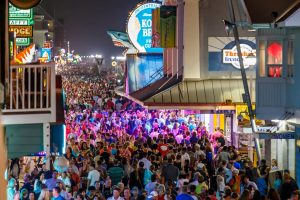
OCEAN CITY — Further evidence of the changing, often dangerous times was on display this week when resort officials approved funding for preliminary design work on a Boardwalk vehicle access control project.
After a handful of events in the U.S. and around the world in which terrorists killed and injured dozens of victims by driving trucks and other vehicles into large public areas where people gather, Ocean City officials began exploring ways to ramp up security in the form of vehicle access controls on the famous Boardwalk. Of course, unauthorized vehicles are not allowed on the Boardwalk, but there are currently dozens of access points where a vehicle could reach the famed promenade.
To that end, resort officials are exploring a series of permanent and semi-permanent barrier systems, from gated access points that would allow police, fire, emergency vehicles and the beach patrol, for example, to access the Boardwalk to heavy planters and bollards in other areas that would prevent unauthorized vehicles from reaching Boardwalk crowds.
City Engineer Terry McGean on Monday presented some preliminary proposals to the Mayor and Council during a work session on Tuesday. The discussion began earlier at the police commission level. McGean said there were currently 36 identified vehicle access points along the Boardwalk that need to be addressed for safety reasons, along with at least three more when the new Boardwalk tram facilities open at 2nd Street and the tram routes are reconfigured.
“We do not physically control access to the Boardwalk for vehicles and that has been a concern,” he said. “It has become an increased concern in light of recent events. These barriers need to be able to stop a medium-sized truck such as a U-Haul that could hit speeds of 30 to 40 mph before reaching the Boardwalk.”
To illustrate just how much damage a vehicle could do, McGean referenced an incident two weeks ago when an apparently drunk driver went on a joy ride through the north-end dune system.
“Just last week, we had a small Ford Explorer drive down the beach on the dunes and take out hundreds of feet of dune fence supported by four-by-four posts,” he said. “They were sheered right off at ground level, and that vehicle was moving relatively slowly in deep sand, so you can imagine what a vehicle traveling at a high rate of speed could do on the Boardwalk.
A tentative Request For Proposal (RFP) outlines the town’s position on the proposed vehicle access control plan.
“At almost any given time, the Boardwalk will have large numbers of pedestrians and bicyclists,” the proposed RFP reads. “During peak seasons, the Boardwalk can become very heavily crowded and pedestrian flow can become restricted. The high volume of vulnerable pedestrians on the Boardwalk, combined with its high recognition factor and ease of vehicle access has become a significant public safety concern to town officials. The town of Ocean City desires to positively restrict vehicle access on the Boardwalk by constructing a combination of permanent, semi-permanent and operable barriers at every potential vehicle access point.”
In terms of funding, McGean estimated the total two-phase project could cost as much as $1 million. He estimated just installing protective bollards and planters at the dozens of Boardwalk access points could cost around $250,000, while the installation of gated systems at some locations, including automated gate systems and manually-operated gate systems could cost in excess of $1 million.
“I anticipate this project to be in the million dollar range,” he said. “This is much more than just putting up wooden barriers.”
McGean said the goal for the vehicle access points on the Boardwalk is to have the Boardwalk fully controlled with at least minimum temporary measures by the summer of 2018. In the second phase, all permanent controls would be in place by the summer of 2019. In response to a question of whether the typical metal bollards filled with concrete would suffice at some locations, McGean said he believed heavier, more permanent barriers were needed.
“Those metal bollards couldn’t do what we want them to do,” he said. “I don’t think they would stop a vehicle of the size were talking about and the speed we’re talking about that we’re really concerned with.”
McGean on Tuesday was requesting approval to spend $80,000 to contract a project designer to begin preliminary design work. The council unanimously approved the request to put the RFP out on the street and jumpstart the Boardwalk vehicle access control projects. McGean explained the physics behind stopping a heavy vehicle going at a high rate of speed.
“Even with a median-duty truck traveling at 30 mph, that’s a lot of force,” he said. “We’re not talking about slowing it down, we’re talking about preventing it from going where it wants to go.”

